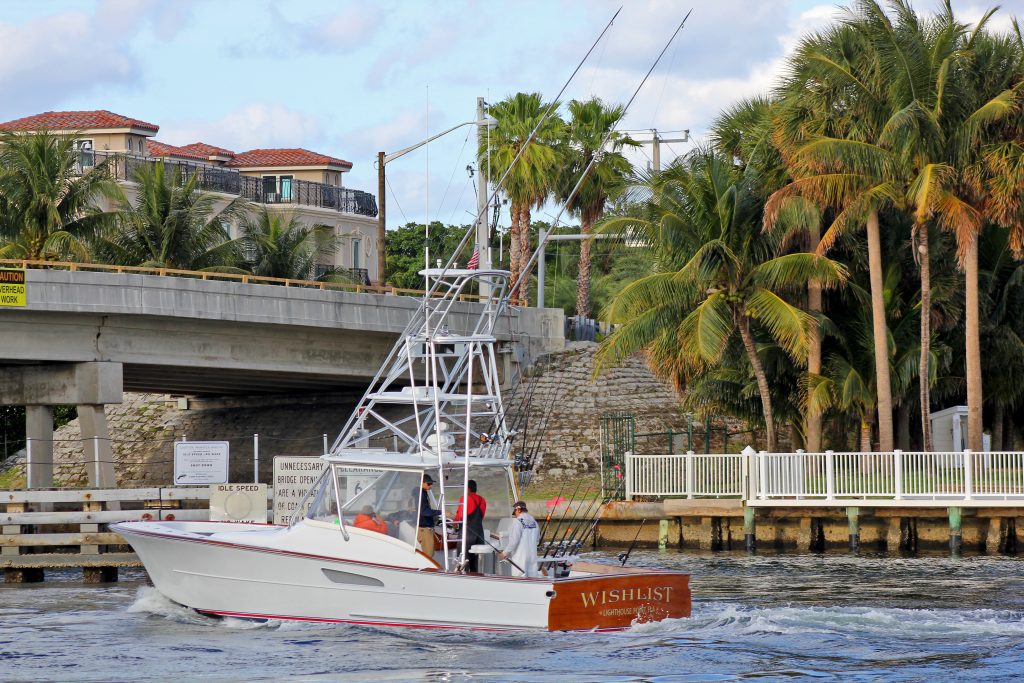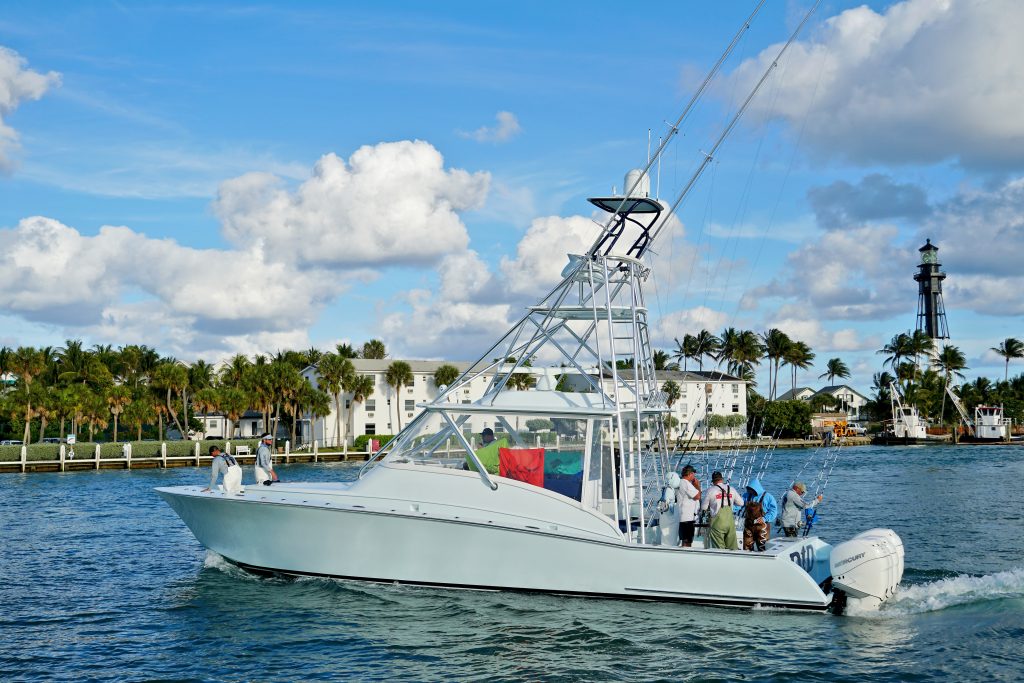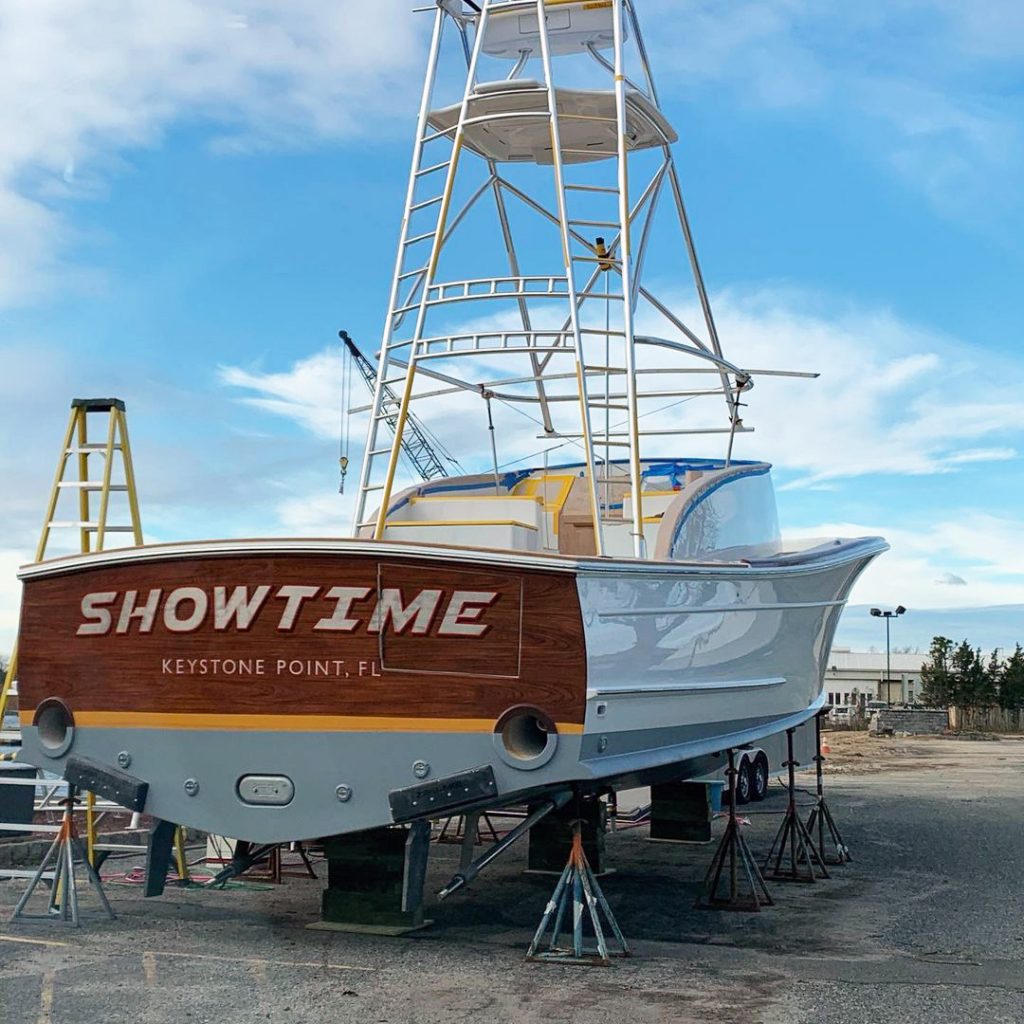Original Article Published: 3/22/2023 | Original Article By: In the Bite Magazine | Please click here for original article.
“To be or not to be.” While this well-known Shakespearean quote is not associated with the boating experience, if we filter it through our marine sensibilities, it just might be coaxed into reading this way: Walkaround, express or convertible sportfish? Now, that’s the question!
Considering our lofty goals when venturing off shore, having the right vessel is paramount to one’s success and comfort at sea. The classic express layout is a favorite of charter captains, delivering an open cockpit with the benefit of a roomy interior loaded with amenities you’d expect to find on a much larger vessel. Fashioned with massive tuna towers, full galleys, multiple staterooms and cockpits lined with plush mezzanines, modern convertibles nearing triple-digit lengths can safely handle the most demanding ocean conditions in comfort and style. However, it is quite obvious that being able to make a 360-degree trek around the deck while that big fish is dancing on the other end of the line is preferable to running out of room and having to throttle jockey into an angry sea.
In the Gulf of Mexico, an oil rig bound express or convertible might be the preferred choice compared to a walkaround, although in the Sunshine State a sportfish boat that fishes more like a center console hits the mark wholeheartedly. These purpose-built platforms certainly make up a small percentage of new builds, but judging by the following five-of-a-kind, it seems that south Florida is in fact the final destination for most walkarounds.
Willis — Wishlist

Above: (Photos/Endless Imagery)
Although Mark Willis has only built one walkaround, it’s quite possibly the finest example of the pedigree that has ever been constructed. Featuring his own carefully nuanced sheer line, this sleek hull was crafted with cold-molded mahogany and okoume, while the deck and house comprise Aircell composites. At 37-feet, this modern game boat built with classic construction techniques exceeds 40 knots at top end and cruises graciously at 33 knots. Ahead of its time for the age, the construction of Wishlist began in 2010, utilizing state-of-the art CNC machinery to complement traditional craftsmanship with increased accuracy and efficiency. The end result is a unique and meticulously tailored platform with the utmost attention given to every last detail and radius.
“They call it a 2012, but we took delivery in September 2011, so we’re right about at the nine-year mark now,” says Wishlist’s owner J.P. Wolfe. “We have about 5,000 hours fishing on that boat, and we were planning to do some updates this summer, like a new teak deck, but this Covid thing screwed that all up. We haven’t really had to do anything to the boat besides a couple new pieces of electronics. Otherwise, Mark’s build has been super solid.”
Much like the architecture of a true express boat, Wishlist, based out of Lighthouse Point, offers easy access to the engine compartment and motor box through either a quick access day hatch on the bridge deck or operated ram to lift the entire deck. Noteworthy for a vessel of this size, a Livos Technologies ventilation system keeps salt to a minimum in the engine room, while bringing air in from the outside of the hull.
“We had a 33-foot L&H walkaround before Wishlist, so it’s not like we were going in not knowing what to expect,” says Wolfe. “Robert Ullberg had been working on a 37-foot hull, and we took everything we liked with the L&H and tried to change some things we didn’t. Most
walkarounds have two or three steps going into the bridge area, and we didn’t want that. Half of the time we fish, there’s only two or three guys on the boat. I’m usually at the helm and didn’t want to run down a bunch of stairs to come off the wheel and help gaff or harpoon something. One step down and you’re in the cockpit, so the guy on the wheel can still be useful. We went with the 37 basically for that reason. Mark said we could go with a 40-footer, but if you do then you have to go with larger engines—then you’re left with a 24-inch step down, so you’ll need multiple steps to access the cockpit from the bridge.”
Also special for its time, the oil change Jarrett Bay — Jichi system features quick disconnect hoses between the Cummins 480 hp diesels. “Back then, they didn’t make a transmission that was small enough to handle anything over 500 hp,” Wolfe says. “So that’s why we ended up with the 480s. If we ever have to replace the engines, we could now go with 550s, but at a mile to the gallon this boat cruises at 33 knots, so you can’t beat that.
“I’m a Northeast guy, and this boat has a sharp entry with more of a round back. It’s perfect for Florida, but up there you want a deep V. Half of our days fishing out of Rhode Island, we are dealing with eight-foot seas stretched out at 12 seconds. In the next five years or so, we’ll probably build a 50-foot walkaround but set up totally different because we want it for canyon fishing. I’ll have Wishlist until I die and then I’m sure my nephew or niece will have it after that.”
Jarrett Bay — Jichi

For the past 30 years, Jarrett Bay has been a premier builder among avid offshore anglers, boasting craftsmanship and attention to detail that is second to none. Their head-turning 46-foot walkaround certainly made a splash in 2016, challenging the status quo of the ultimate offshore platform while continuing to embody the qualities that have left Jarrett Bay owners satisfied for decades.
“Gary Davis was the designer of the aptly named 46-foot Grander, since renamed as Jichi, and worked closely with the owners,” said Tate Lawrence, Vice President of Jarrett Bay Boatworks. Cold-molded boats, delivering strength and durability, without compromising weight and performance, have been, and continue to be, the hallmark of every custom build the Beaufort, North Carolina-based company produces. “Our niche in the market lies in the fact that our customers can’t find a builder to deliver what they want. We always start with a blank sheet of paper and a pencil,” Lawrence added. “You tell us, watermaker, gyro system, whatever…we’ll make it fit.”
Starting in 1991 with the 34-foot Pipe Dream, Jarrett Bay’s express lineup includes Sea Salt and Miss Shell, also 34-footers, the 46-foot Double G, and a host of others. It was only a matter of time before Jichi, a daring, over-the-top, one-of-a-kind, cold-molded design, would set the bar for walkaround boats even higher. Given her weight, displacing some 35,000 pounds, her owners chose a pair of CAT 1,136 hp C18 ACERT engines with a 360 joystick system, 21.5kW CAT genset, and a Seakeeper 5 gyro.
The collaboration between Jarrett Bay’s design and engineering and the owner’s vision has resulted in a truly unique machine; from her bold, exterior shape, metallic gray Alexseal paint, powder-black accents, to the teak toe rails and deck, to the spectacular helm with its impressive electronics display, Jichi occupies a special place in the rarified air of deep water predators and is still one of the most advanced and immediately recognizable walkarounds ever constructed. The previous Jichi was a 61-foot Paul Mann, hull no. 37 that is now Grand Slam, and you can be certain this 46-foot walkaround with its experienced owners will soon be gracing the winner’s circle along south Florida’s demanding tournament circuit.
Jim Smith — D&D

Above: (Photo/Endless Imagery)
John Vance has been crafting custom walkarounds since 2016, first delivering the 60-foot Dona Re with twin MTU M94 diesels rated at 1,250 hp. Next was a 43-footer with outboards that was built as a tender to the 86-foot Jim Smith Sapelo. Then, it was the 48-foot Two Krickets, and the 60-foot Eurybia powered by a pair of 1,650 hp MTU 96L diesels. However, the newest 48-foot walkaround D&D, with 38 rod holders lining the gunnel cap, hits the sweet spot for tournament anglers with a penchant for fishing live bait. With four Mercury 350 hp outboards hanging on the transom, this superb display of what a walkaround should be holds 800 gallons of fuel and delivers excellent range, response and maneuverability, with a top end speed nearing 50 knots.
While speed is clearly an advantage of outboards, without inboard power taking up space in the sole, the cockpit allows for the addition of two in-deck livewells flanking the lazarette, where a seachest ensures the steady flow of clean seawater to keep baits lively. Where you’d typically find a fishbox, the transom was reconfigured to fit a third livewell. Another convenience this walkaround brings to the table is its elevated, express-style bridge deck with centered helm station. Although walkarounds often sacrifice cabin space to accommodate the design, the choice of outboard power allows for a stateroom under the helm deck rather than losing the space to an engine room. Cabin access is offset to starboard of the helm, leading to a functional space, with the single stateroom aft providing a queen berth. A head and shower are situated to port, with galley starboard.
Providing the accoutrements of a vessel much larger in size, this sleek craft is perfect for owner/operators and families with children. And whether coming into a slip or casting to a tailer, you are much safer in the boat instead of working on top of the foredeck.
Release — Showtime

Capt. Nick Carullo, 2019 InTheBite Captain of the Year, has experienced great success along south Florida’s sailfish circuit fishing aboard a quad outboard powered 42-foot Invincible Showtime, although the Miami-based team recently made a big change to their program. The Release 46 is available in express and convertible platforms, but the uninterrupted deck of their walkaround model is designed and equipped in such a way that particularly appeals to Florida fishermen who most often drift and dream with a wide kite spread.
Showtime, like all Release boats, was built with 100 percent composite construction, incorporating vinylester resins, Kevlar, carbon, biaxial and triaxial woven fiberglass cloth and composite cores throughout the hull areas. Stringers are foam filled and fully encapsulated with fiberglass laminates, then reinforced with a carbon composite layer for additional strength. All of this is vacuum-infused, resulting in the optimal resin-to-cloth ratio.
When we spoke to Capt. Carullo, the boat was being delivered to Miami from Egg Harbor, New Jersey. “I’m really dying to see it. This boat is going to have a Seakeeper, so that will be a nice change. I loved fishing our Invincible, but it did tend to rock. I’ve ran a few big convertibles before, but this size range should be fun.
“I’m curious to see how it runs compared to an outboard boat with quads. I know for certain that it’s going to be much more comfortable when the weather forecast takes a turn for the worse, and the fishability that we went for with this boat is just next level. We put a removable livewell in the bow that is going to be a nice little touch for either casting at a free jumper or tailer. The boat is also plumbed with a transom well and two on deck wells for traveling, then we’ll have Scott Alvarez plumb his Wicked Wells behind the stanchion.”
Showtime will feature Pompanette helm chairs and rocket launcher, RUPP outriggers, Garmin electronics, Lumitec lighting, Veem propellers and two Best Marine sea chests for redundancy.
“We also increased the size of the transom livewell and installed two big pump boxes,” says Carullo. “The removable livewell/bench seat forward of the house is a first for us. The faux teak handrail around the bridge deck was something else we’ve never done before. Interestingly, we started with a real teak helm pod, and ended up painting faux over the teak, which was kind of heartbreaking, but it actually looked better,” says Jim Turner of Release Boatworks. The gap tower was completed by Palm Beach Towers and the build is ultimately highlighted by MAN i6 diesels producing 800 hp at 2,300 rpm.
“When I started, I never wanted to build a walkaround. It was never my intention, and it just became what I never expected it to, which was so much more of a family friendly boat. It’s just everything that a typical center console can be, plus the amenities. Here we are, I think we have 13 boats sold this year, and all but one are walkarounds,” Turner says. “And we just signed two contracts for our new 55-foot walkaround that’s going to have a traditional flybridge and salon.”
Pelagic — Skipjac

Designed by Randy Towe and built in 2001, this 43-foot walkaround was the first of its kind to be fashioned with a flybridge. Also unique in Randy’s design is the fact that the distance from the top of the covering boards to the deck is consistent 360 degrees around the boat. Two decades later, it is still one of the most distinguishable boats ever constructed. Originally named Quit Yer Bitchin and built on a 43-foot Oscar Torres hull with twin 730 hp MAN diesels, Skipjac as she rests today at her slip in Pompano Beach is much different than the original platform and is the new owner’s pride and joy.
The superstructure looks the same, although freshly painted, and the boat has since been re-hulled and outfitted with new MAN R6 800s, transmissions, generator and running gear. The interior was also recently gutted and fashioned with new countertops, teak walls, shades, window frames and a completely fresh layout. Bernard Paul-Hus has owned the irreplaceable boat since 2007 and has been in love with the signature build ever since. With the normal limitations of the Oscar Torres hull running about 17 knots in three-foot seas, Paul-Hus contracted Steve French at Applied Concepts to determine the best new hull form to achieve more desirable attributes.
“After a thorough analysis of the boat’s existing conditions, including power, weight, pressure and estimated balance and center of gravity, we created a computer model of the existing hull. Then we modeled several hull forms to determine what would fit the existing boat. When we found the sweet spot, we made a jig and literally built a new bottom for her. We dropped the keel nearly nine inches through the mid body,” says Steve French.
“It went from being a flat-bottomed lobster boat, to a boat that I can run into a sea with. When you see me on day one of a tournament, I’ve got 950 gallons of fuel, 200 gallons of freshwater, 200 gallons of saltwater, nine guys, and that boat will still get up and cruise at 29 knots. And I’ve never stuffed the bow, even in some rough shit. I’ve put 5,000 hours on the hull since it was reworked and we’ve had no issues,” Paul-Hus says.
“I’ve certainly made a lot of upgrades, but Randy didn’t get anywhere near enough credit for the smart engineering that went into the boat when he first built it. Next, we’re going to modify the transom to recess a Humphree trim system. We’re also putting in a Furuno CH-500 omni directional sonar.”





